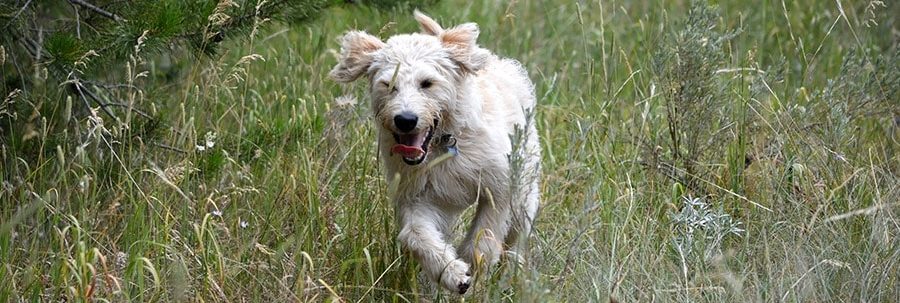Labradoodles are a loving and intelligent breed known for their sociable and sometimes goofy personalities.
They’re a very active breed that requires regular physical and mental exercise to stay happy and healthy.
But the activity level and requirements of a puppy are much different than that of an adult dog.
How much exercise do Labradoodle puppies need? As a puppy, a good rule of thumb is 5 minutes of exercise for each month in age they are, up to twice per day. So at 3 months, it would be 15 minutes 2x per day, 6 months is 30 minutes 2x per day and so on. Labradoodles are always ready to play whether it be a run or hike with their owner or a game of fetch at the dog park. But their love for their humans will bring them close when it’s time to relax for the evening.
3 Months Old = 15 Minutes (Twice a day)
6 Months Old = 30 Minutes (Twice a day)
9 Months Old = 45 Minutes (Twice a day)
A fully grown Labradoodle can exercise much longer.
But what if I have more time than that, should I exercise them as frequently as possible? In short, no.
A young and developing puppy is still at a stage where they need rest and recovery. Excessive exercise may overtire them and possibly cause joint pain.
During the first year, dogs are developing their skeleton, tendons, ligaments, and joints.
Especially during the 14th to 26th weeks, they are going through growth spurts, so take care to note if they seem tired.
As an owner of 2 Labradoodles myself, I know how tough it can be to find good information. In the 60+ pages of this book, I share the information, resources, and breed-specific tips I wish I’d had from the start. You will save you time, money, and loads of frustration…take my word for it!
It’s perfectly normal to have concerns about your pup or lack confidence that you’re doing everything correctly.
That’s why we put together our latest book, The Owner’s Guide To The Perfect Labradoodle. Why do you need it?
Well, those new to Labradoodles often have incorrect notions about temperament, sizes, shedding, grooming, and training.
In our guide, we clear all that up and present you with an honest look at these dogs and teach you not only how to care for and raise them the right way but also how to enable them to truly thrive.
You’ll appreciate all the tips and first-hand knowledge that only comes with experience. A must-have for all Labradoodle lovers!
Now, let’s go over exercise guidelines for these sweet, adorable pups.
What Type Of Exercise Is Best?
Try and think in terms of a steady pace they are comfortable with, for a short amount of time. Progressively the walks can get longer.
Cycling, jogging, or running are not something a puppy can keep up with. Similarly climbing a lot of stairs or going up hills would be harder for them to do.
If you have children be sure to note how they play with the puppy as they can easily get overwhelmed when at such a young age.
| Perfect for Puppies | Too Much Stress |
| Casual walks with a leash around the block. Let him stroll with you. | Jogging or cycling for long or even moderate distances. Let the puppy set her pace; don’t make her keep up with you. |
| Free play in a backyard or park for a short while. | Long stretches of running and strenuous play. |
| Walks around the house or apartment. | Climbing stair or hills/too much play with kids. |
| A short, low-stress game of fetch. | Long sessions of fetch or similarly high-energy play. |
What Type Of Leash Do I Use For Walks?
It’s best to use a fixed-length leash and not one of those retractable ones. Retractable leashes make it difficult to control your dog if they’re far out and they can get you tied up like a bow!
We like this leash because it comes in short lengths (4′ & 6′) and has a 2nd handle near the dog. This is a great feature for tight spaces or when you simply need more control of your pup.
What About Collars and Harnesses?
There are definitely a lot of options here, and if you’re having trouble after reading this you should talk to your vet or dog trainer to get their advice.
In general, you’ll want to make sure you keep up with the sizing on the collar.
As a rule of thumb, you should be able to fit 2 fingers easily in the collar to make sure it’s not too tight. Also, make sure your dog has tags to identify her if she gets free from you.
See our favorite harnesses, leashes, and collars here.
Standard Flat Collar
Typically a nylon or leather strap. Since it’s the most popular collar type, you’ll find it in most pet stores or can grab one on Amazon.
Some breeds may slip out of these easily so you’ll want to make sure it’s a good fit. Labradoodles should not have this issue, so it is a solid choice for them.
Back-Clip Harness
The Back-Clip Harness, like this Ruffwear Front Range Harness, is a very common harness style.
They’re especially good for dogs with a short muzzle like a Pug (so cute! Learn more here) or other smaller breeds.
It’s also best for dogs who can have issues with pressure on their neck.
Tracheal collapse is a condition when the dog’s trachea becomes injured, and a hard tug with a standard collar might cause this.
You can always check with your breeder and vet, but as tracheal collapse can happen in miniature poodles, for miniature Labradoodles this is a preferred collar type.
One minor downside to this type is it’s not great for dogs who have a tendency to pull and tug owners.
You’ll want to practice a “loose leash” walk with your dog if you see this happening.
Front-Clip Harness
As the name implies, you clip the leash to a loop on the front of the dog’s chest. Here’s one of the most popular harnesses on Amazon.
It’s easier to control and steer the dog with this design, and it’s good for practicing a loose leash walk.
What About Mental Stimulation?
Exercise is great but you also need to make sure you’re socializing your puppy. Lack of mental stimulation can result in destructive behaviors from your pup.
To learn more about this and the added benefits of mental exercise, we put together our favorite games and tips for Labradoodles.
All puppies need a good foundation to start from. When born, a puppy needs to get used to handling and contact with their human friends.
Holding their paws, touching their muzzle, tail, ears… all go towards the goal of getting them used to experiences with people.
Vets and groomers will be handling them along with owners, and it’s a good idea to get that process started.
Letting puppies get used to sounds and sights is encouraged, and starting at a few weeks old you can let her explore.
This is just the beginning of the process known as socialization, which you can learn more about in our detailed guide.
Attention and contact are great stimulation, as well as playtime. Just be mindful they are still very young and developing!
Still have questions or concerns? Chances are you’ll find the answer in our Labradoodle guidebook, and I really can’t recommend it enough.
We covered everything from obtaining your puppy to surviving puppyhood in one piece to caring for adult dogs.
If you want to raise a happy, well-adjusted Labradoodle and be a pro as a caregiver, this is the only book you’ll need.
Related Questions:
What is a Loose Leash Walk?
A loose leash walk is the ability to walk your dog at your pace without him pulling you along.
The dog is accustomed to staying near you and letting you take the lead. This takes some training and practice.
There are a few ways to train a dog to do this. Among them are working with no leash and rewarding them for staying nearby.
Other methods include gently encouraging them to stay at your pace with the leash. For example, if they pull forward you can stop, cheerfully call them, and take a few steps back.
It’s something a good trainer will be able to help you with, and you can find a number of videos on this topic. Here’s an example:
Remember that it takes patience and repetition to train a dog properly. It will not happen immediately in most cases.
In the end, she will naturally follow you along and at your pace. Smaller Doodles might be easier to keep near you, while larger ones might tend to pull a bit more.
Each dog is unique though! If you struggle with it, try and find a professional early on.
How much exercise should I expect when my Labradoodle is full-grown?
Labradoodles, in particular, can be high-energy dogs, so as they grow you should be sure they get enough attention and activity.
We have an entire guide covering exercise from puppy to adult, including our favorite activities, which you can read here.
Ample room both indoors and outdoors are ideal for this breed. They are athletic, active and agile. It’s not a breed to sit and nap all day; they tend to like to be on the go.
Like people, they will work their way up to more strenuous activity. At full grown, they will be active and playful!
They typically love the water and are natural swimmers. As a retriever breed, a nice game of fetch is always a good idea!
Remember that each puppy is an individual. Regardless of his size, parents, and breed, each puppy will have his own personality.
How long do Labradoodles live?
Some studies have shown that mixed-breed dogs have a greater life expectancy than pure breeds. Your Doodle might surpass either of its parents in age.
A Lab’s life expectancy is around 12 years, and Poodles have a life expectancy of 10-18 years. Smaller Poodles tend to live longer and Poodle mixes from a small Poodle may do likewise.
So again, talk to your breeder, and see what the lineage of your puppy is. How healthy are her parents; how old were her grandparents?
You can have at least a good idea of what you might expect from that information. A trip to your vet can confirm her health and of course, get her any needed shots.
Ideally, your Labradoodle will have a lifespan of 12 years or more! Providing your dog a safe and nurturing home can only help her.
Proper nutrition, care, socialization, and exercise will all help your Doodle live a long, happy life.
Hungry for more? Check out all of our Labradoodle articles to become an expert on the breed.
Last update on 2024-04-27 at 04:34 / Affiliate links / Images from Amazon Product Advertising API









